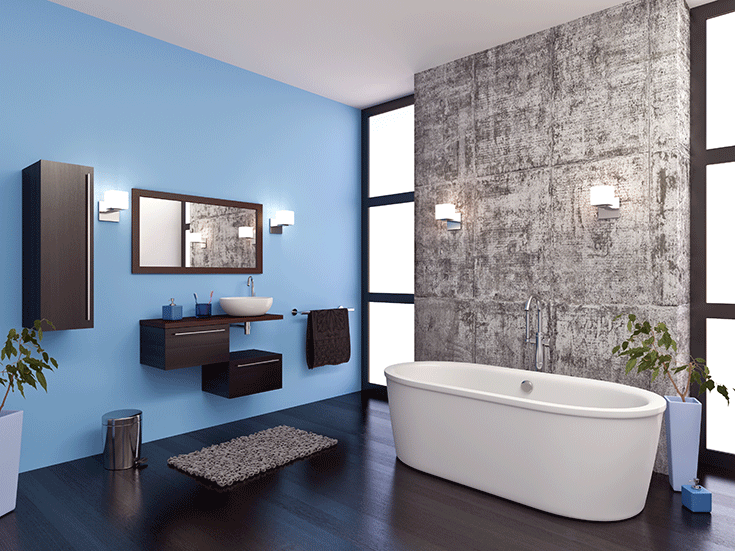
When it comes to renovating bathrooms, even the most basic changes can be tricky. There are many components involved in transforming the look and transfiguration of a bathroom, and not only must they be done in the correct order – they must be done the right way from the get go. If not, you can end up with problems in your electrical circuits, plumbing, waterproofing and drainage. Here we go through the most important aspects of a bathroom renovation – the elements you need to consider before going ahead, as well as ways to budget and plan for the renovation result you’re after.
Be realistic
Don’t kid yourself into a DIY bathroom renovation when you’re not qualified or if you don’t have the resources for the job at your disposal. Before even thinking about what type of renovation you want to do, be brutally honest with yourself about your own skills and capabilities, and take time to consider exactly what’s involved before, after and during the renovation process. Which aspects could you complete confidently, and which should be left up to the professionals?
Budget
Effective budgeting involves two considerations:
- How much money do you need for the renovation?
- How much money can you afford for the renovation?
Setting out clear expectations will help you in the long run as budget will dictate almost everything else in your bathroom renovation plan. One way to look at it is – by understanding what you can afford, you will know which aspects of the bathroom you can replace; which areas you can refresh; and which areas might require a little creativity for inexpensive improvement.
Your budget should factor in:
- The cost of contract work
- The materials needed for the job
One sure way to bust your budget is to move your plumbing. This will require qualified tradesmen such as plumbers and electricians who will be paid an hourly rate. Definitely consider revamping your existing bathroom fixtures, as opposed to performing a complete overhaul. Resurfacing and refitting is less expensive and can be just as effective at giving your bathroom that new look you’re aiming for.
Remember, if you do have your heart set on moving around the plumbing in your bathroom, this will mean you cannot use this bathroom for the interim. If your place doesn’t have a second bathroom, consider hiring a port-a-loo and/or arranging access to a bathroom at a friend or family members home whilst the renovation is in process.
Hiring contractors
According to renowned contractor, Stephen Fanuka, of Million Dollar Contractors fame, if you hire contractors you should pay a third of the renovation costs as a deposit, then pay the rest of the bill on a weekly basis. He recommends your weekly payments should be based on the percentage of work that has been completed – keeping the last 10% of your budget withheld until the job is completely finished. This keeps everybody motivated and on track, and by planning this way you should get the best value for money. Some of the contractors you might employ include:
- Plumbers
- Painters
- Architects
- Interior designers
- Electricians
- Builders
- Carpenter
- Tiler or flooring specialist
- Waterproofer
- Spa or sauna specialist
Using registered and insured tradespeople also means that you are legally and financially covered if there is ever a problem with the job. As well as this, registered contractors are required to be up-to-date with the latest innovations, building codes and standards as well as local government regulations.
To establish which contractors you feel comfortable hiring, you can check trade licences and registration with your local council or simply use a member of an established industry body such as the Master Plumbers Association.
Coordinating trades
For your bathroom to be renovated effectively, on time and to budget – organisation is key. Every tradesperson needs to be coordinated efficiently to get the project completed without mistakes or oversights. You wouldn’t bring a painter in before the waterproofer, and you certainly wouldn’t bring in an architect after the job has been completed. Having contractors on site when they aren’t needed can be costly, and result in project mishaps. When you’re planning contractors, it’s all about planning ahead, coordinating the order and keeping things organised.
Understanding your existing space
In planning your bathroom renovation, it is important to measure the existing space so you can establish what you’re working with. Measure your bathroom as accurately as possible, any slight mistakes could wreak havoc later down the line and impede your design plans. A simple sketch of a space will also be a useful spacial guide so you can understand how and where everything is placed (particularly if you aren’t moving plumbing and need to work with what you’ve got).
Here is a quick guide of what you should measure:
- Floor to ceiling
- Distance between walls
- From corners to doors
- Size of doors and their height and distance from the floor, ceiling and wall edges
- Size of windows and their height and distance from the floor, ceiling and wall edges
- Plumbing and pipes should also be included in the layout but this may be tricky if you don’t have an old plan of the bathroom.
- You don’t need to measure power outlets but include them in your sketch
Drawing up your new design
This might sound like the most enjoyable part of your bathroom renovation – establishing what you’d like to create with your change, and how you’d like your new bathroom to look and feel. But, before jumping into it, there there are some certain questions you need to consider. These include:
- Will you be moving plumbing?
- Will you be transforming the space into an en-suite or will it be a self-contained space?
- Will you be restructuring the space and altering elements such as the floor, walls, and fixtures?
- Do you currently have enough storage space or do you need more?
- Will laundry facilities need to be added or removed from the space?
Professionals that can help you with this phase of planning include architects, interior designers and builders. These professionals have the expertise and knowledge of how best to approach your bathroom renovation. If you consult a professional, and you already have a clear idea of what you’re after, you can save both time and money by streamlining the process. Some designers and architects will measure the space themselves and draw up their own designs to ensure they have accurate measurements and appropriate features, but it doesn’t hurt for you to do your own research and investigation of the space. After all, it is your bathroom so try and have as much input into its design as you can.
Environmentally friendly options
Another factor to consider when planning your bathroom renovation is if you want to go with a traditional bathroom design or a more contemporary ‘green’ design that focuses on environmental sustainability.
Green bathrooms aren’t just good for the environment they are good for you too! From lighting to water usage, going green will actually save you money in the long run. ‘Going green’ doesn’t have to involve big changes, they can be small elegant solutions that can be easily incorporated into any design.
For example, by simply changing the showerheads in your bathroom you can prevent 18 litres of water being wasted a minute and save $100-$150 on your annual water bill. And, by switching all your bathroom lights to low-energy bulbs like fluorescent bulbs, you can save on energy costs and your lights will typically last 10x longer than usual.
It’s also a good idea to consider alternative hot water systems such as gas and solar power that can be installed during the renovation, as well as eco-friendly materials such as low or no VOC products (paint, sealant, etc) that are also better for your health. Having a green bathroom can also mean upcycling your current fittings and fixtures so they don’t end up in landfill.
Staying safe
Contractors and tradespeople will know to look out for hazards that you might not be aware of in dismantling and reconstructing your bathroom.
For example, most of us know that asbestos is extremely dangerous. With approximately one third of all homes built in Australia contain asbestos products, if your home was built before the mid-1980’s than it is highly likely you will be affected. Asbestos containing materials (ACMs) could be in your bathroom’s wall sheeting, vinyl sheet flooring, tile underlays, waterproof membranes or concrete formwork. If you believe you might have asbestos in your home, you may need to hire a licensed asbestos handler to remove it.
For more information on asbestos visit the Asbestos Awareness website. This website contains images, resources and more, that can help you identify and determine what course of action you need to take when renovating your home.
Keep things compliant
If you are going to purchase tiles, vanities, plumbing fixtures, accessories, etc yourself as a way to avoid paying the extra fee from contractors (or to have a bit more control over your bathroom design) than you need to mindful that every product needs to comply with Australian standards of quality and safety.
With an increase in building materials being imported into the country from overseas, many DIY renovators see these products as cost-effective options. But in the long run they’ll actually cost you more, if they do not comply with standards and regulations around energy, safety and water usage. To avoid issues down the line, either talk to your contractors about their recommendations or only source products through reputable stores that sell approved materials.

 02 9624 7099
02 9624 7099





